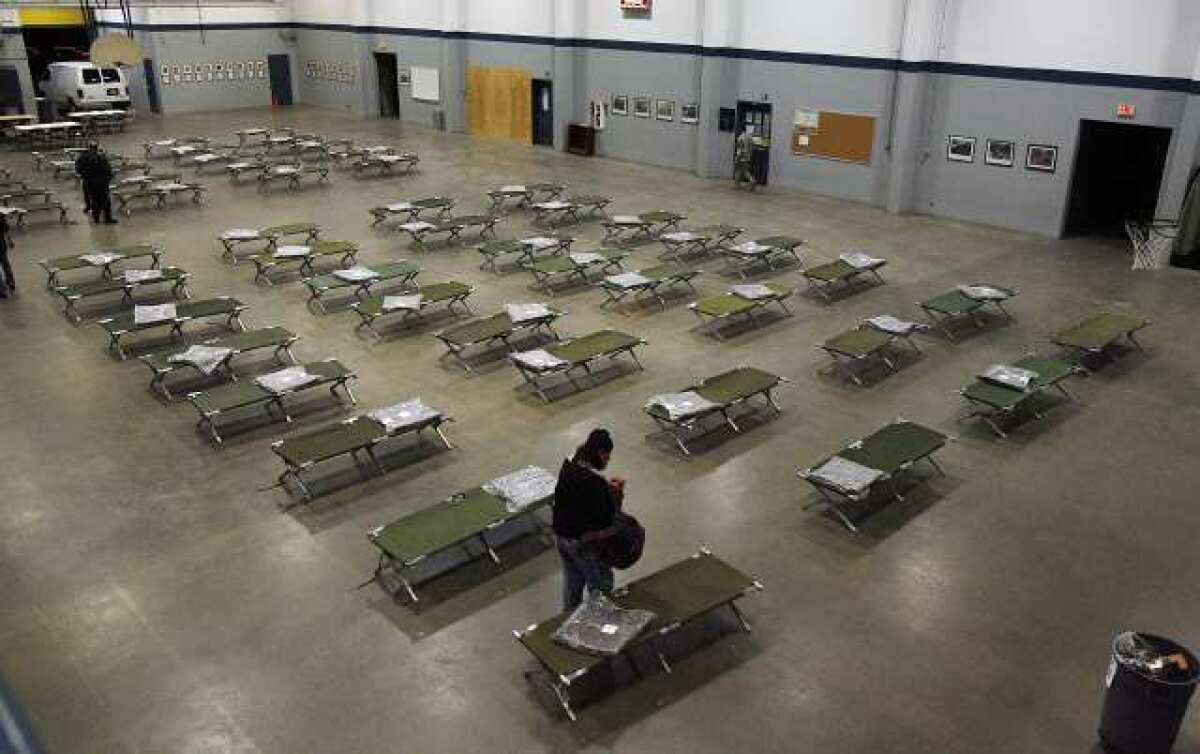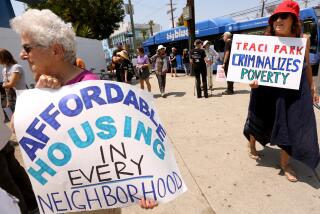Op-Ed: Building more permanent housing alone won’t solve homelessness in California

Homeless people should have a legal right to shelter and a legal obligation to utilize it.
- Share via
While serving in the state Legislature, I authored California’s Mental Health Services Act and later sponsored its housing offshoot, No Place Like Home. The idea of the legislation was to establish a “housing first” mentality in California that prioritized getting people off the streets and into permanent housing, where they could then get supportive services for mental illness, substance abuse and other issues.
I still believe strongly in the concept of housing first, but I’ve also come to see that focusing primarily on permanent housing is insufficient. We simply don’t have the housing stock necessary to address our current crisis, and building it will take too long and cost too much. We need an infusion of short-term shelter and housing options to serve as a bridge for those currently living on our streets.
Today, some 130,000 Californians are homeless. More than two-thirds of them are living outdoors, where they are vulnerable to disease, violence and deterioration of their mental and physical health. Record numbers of them are dying. In Los Angeles, deaths among the unsheltered homeless are up 76% over the last five years. In Sacramento, where I am mayor, unsheltered homeless deaths are up 75% since last year.
We now have a new governor who has vowed to make reducing chronic homelessness a top state priority. His first budget showed he is willing to back his promise.
But what will it take to get there? First, we need to establish the legal right of all people to sleep inside either through executive, legislative or court action. Establishing this right is a necessary prod for our state to build sufficient shelter. Second, we need to establish an obligation for those camping on the streets or on the riverbanks to come inside. And third, we need to have enough places to house ― even temporarily ― those who don’t have access to shelter, because the courts have been clear that cities and counties can’t enforce illegal camping laws unless shelter is available.
A housing first approach is still crucial. Desperate people need to first be gotten inside before intensive support and services can be effective. But we need options beyond permanent housing, and we simply don’t have enough.
For a model, we can look to New York.
Nearly 40 years ago, New York City began implementing a court-ordered consent decree under a lawsuit known as Callahan vs. Carey. The lawsuit was brought on behalf of several men who were denied beds in shelters that had no space, and the court’s ruling required the city to provide indoor shelter to all its homeless residents.
In the decades since, the city has met its obligation by placing people in hotels, motels and so-called clustered apartments. Critics have said the city’s policies encourage people to stay too long, but the shift undeniably has provided reliable shelter for the vast bulk of New York’s homeless residents.
Now the city is phasing out its old approach. Instead of run-down apartments and hotels, it is constructing 90 high-volume shelters, adding wraparound services, and committing to more aggressively moving people into longer-term or permanent housing.
In 2019, New York City will spend about $1.6 billion to shelter 75,000 people. Our unsheltered population numbers about 90,000. I believe the cost of getting them indoors would be a bargain considering what California spends on public safety and cleanup without actually getting people off the streets. I think Californians would overwhelmingly agree.
For the approach to be effective, though, it needs to be coupled with a requirement not included in the New York approach. The right to shelter must be paired with the obligation to use it. Living on the streets should not be considered a civil right. And once people are sheltered, they need to receive treatment and support that can help them remain housed.
The good news in California is that we are already starting to move in this direction. New state investments combined with voter-approved local dollars have provided resources to expand high-volume, service-rich, low-barrier shelters, known as navigation centers or bridge shelters.
Cities and counties are also transforming their shelter approach. Instead of simply allowing people to stay indefinitely, many shelters now perform immediate assessments to understand what caused an individual’s homelessness. They then coordinate intensive case management and whatever supports and housing options are needed to help people into permanent housing. Some shelters are also allowing their clients to bring pets, possessions and partners, three barriers that have in the past discouraged people from seeking help. The new approach is working for thousands of people.
But much more is needed if California hopes to accommodate another 100,000 or more people in temporary shelters. Gov. Gavin Newsom’s January executive order identified 1,390 vacant state parcels suitable for development, and that’s a good starting point. We will also need to find ways to reduce the opportunity for endless legal challenges from those who don’t want shelters placed near them.
If homelessness is the public health, public safety, and moral crisis we say it is, then we must actually treat it that way. We cannot wait half a decade or more to complete our long-term housing vision.
Darrell Steinberg is mayor of Sacramento and co-chairman of California’s Commission on Homelessness and Supportive Housing. He is former president pro tem of the California Senate.
More to Read
A cure for the common opinion
Get thought-provoking perspectives with our weekly newsletter.
You may occasionally receive promotional content from the Los Angeles Times.










